Jaw Stiffnessaccording to TCM
Symptom family: Jaw Conditions and Symptoms
Did you mean? Jaw Pain
What is Jaw Stiffness?
Jaw stiffness involves a reduction in the mobility of the jaw, which can lead to difficulty in opening the mouth fully and can be accompanied by pain or discomfort.
Medically known as trismus, this condition often arises from complications related to the temporomandibular joint (TMJ), but can also be due to trauma, dental issues, or systemic diseases. The stiffness can be transient or chronic, potentially affecting speech, chewing, and overall quality of life.
How does TCM view Jaw Stiffness?
Traditional Chinese Medicine (TCM) perceives jaw stiffness not merely as a localized dilemma but as a symptom signaling deeper imbalances within the body’s energetic system. TCM postulates that such stiffness could stem from the Stagnation of Qi—vital life energy—in the meridians that traverse the jaw area.
Another common TCM diagnosis might involve an invasion of Cold or Dampness that causes constriction in the muscles and joints. Understanding these patterns is pivotal, as TCM treatments are tailored to rectify specific disharmonies, whether by restoring the flow of Qi, expelling Cold, or drying Dampness.
Acupoints for Jaw Stiffness
To alleviate jaw stiffness, TCM turns to acupoint therapy, an integral component of acupuncture. The acupoint Jiache ST-6 is frequently employed, located on the Stomach meridian, which traditionally is believed to influence facial muscles and the jaw.
Stimulating Jiache is said to dispel Wind, a pathogenic factor that TCM correlates with symptoms like stiffness and immobility. Such targeted therapy is aimed not only at easing the symptom but also at harmonizing underlying imbalances, thereby addressing both the manifestation and its root according to TCM philosophy.
See more details below about Jiache ST-6, an acupoint used to address jaw stiffness.
- By Meridian
- Stomach Channel

Jiache ST-6
One finger-breadth anterior and superior to the lower angle of the mandible where masseter muscle attaches at the prominence of the muscle when the teeth are clenched.
